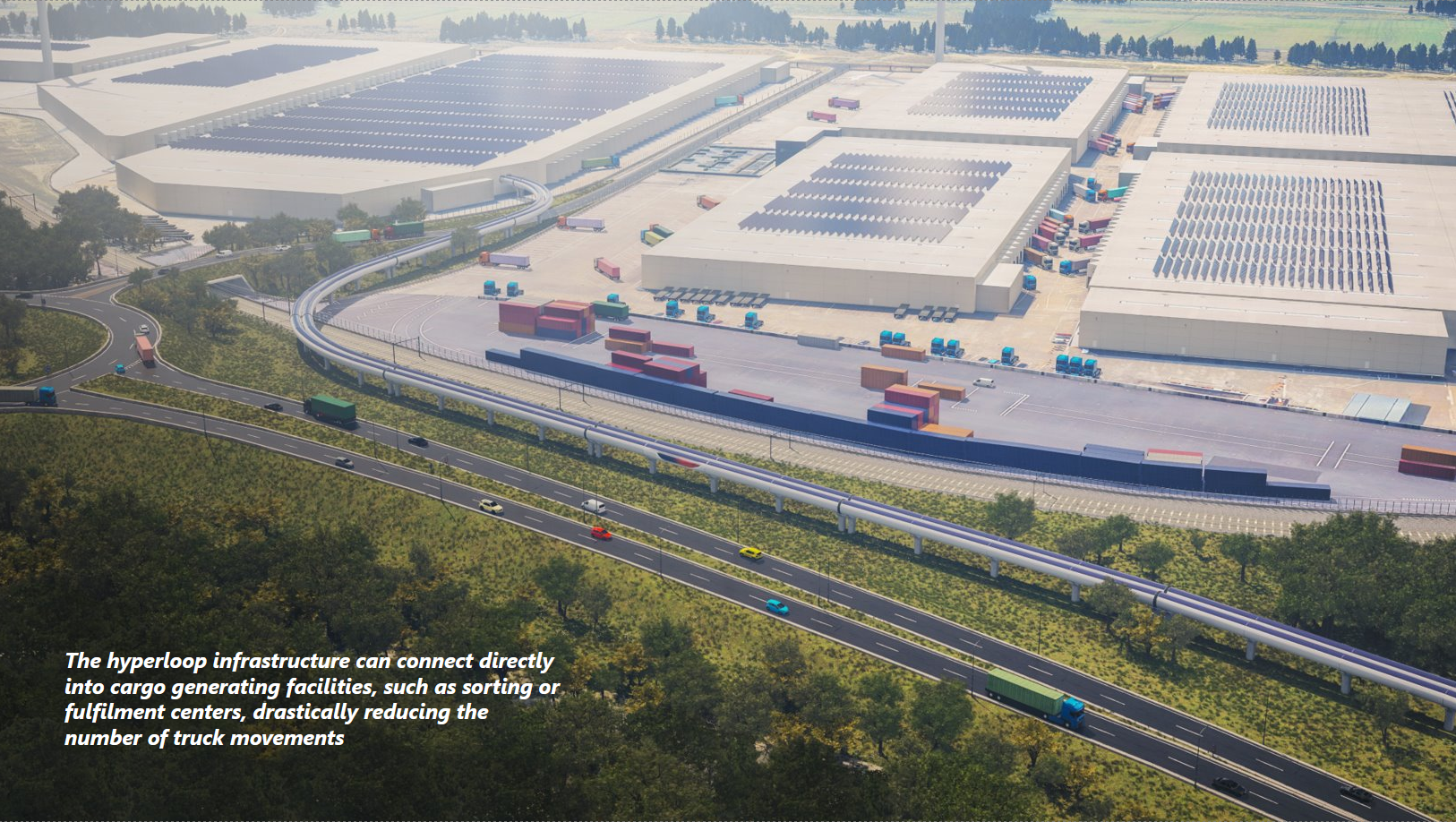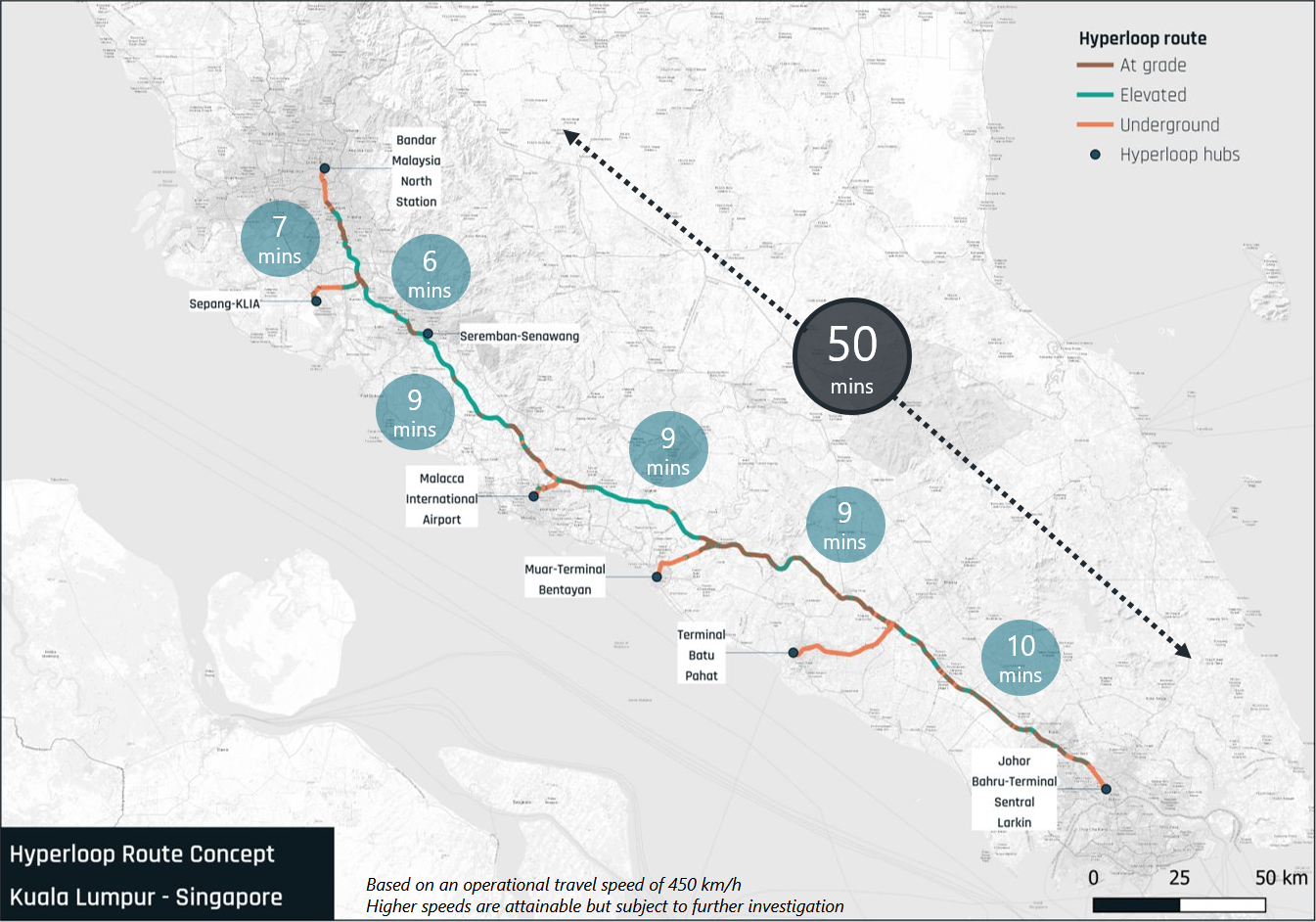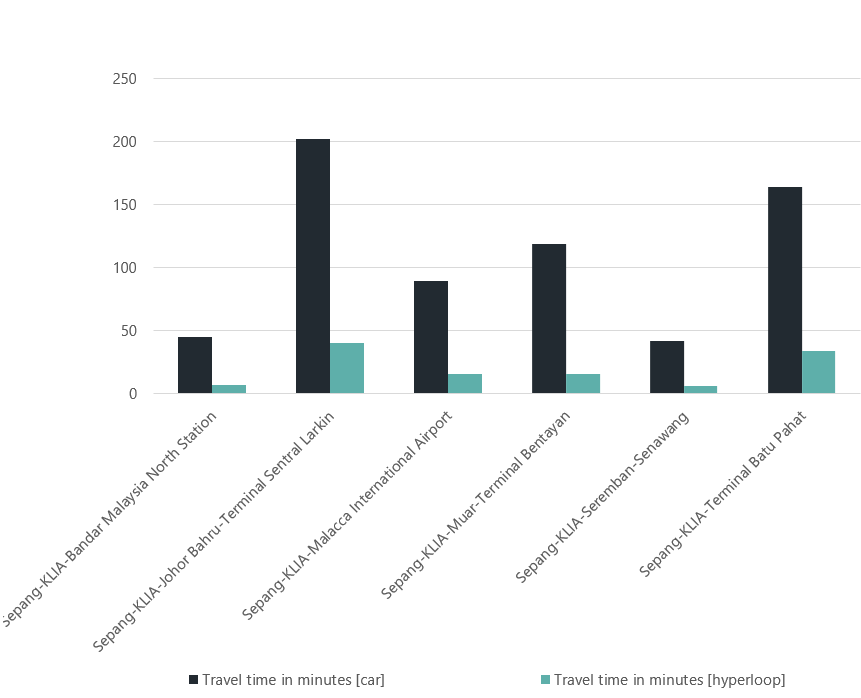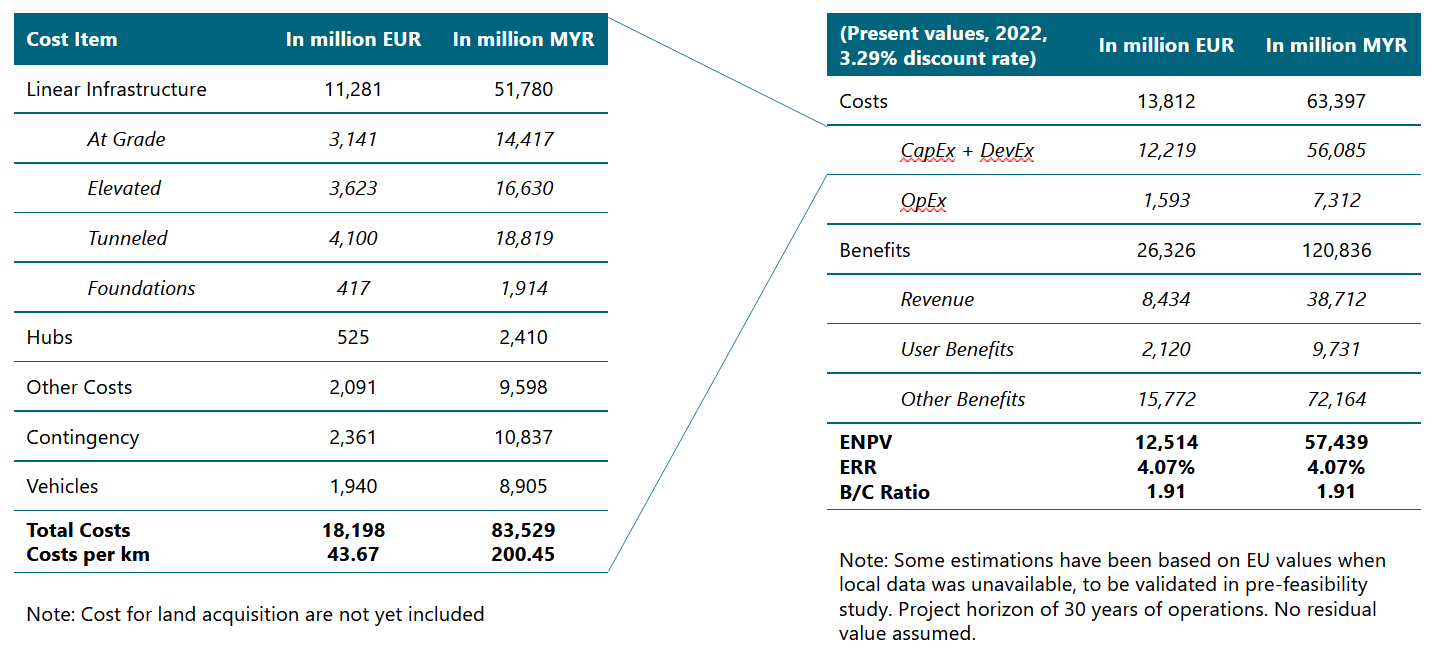A route concept study on the Kuala Lumpur - Singapore connection

This study, from April 2022, delves into the revolutionary transport technology of hyperloop and its potential to transform passenger experiences and cargo movements. Specifically, it examines the possibility of implementing a Kuala Lumpur to Singapore link using hyperloop as an alternative to high-speed rail plans that were recently suspended. Hyperloop has the ability to integrate with existing transport networks and contribute to city-shaping, place-making, economic growth, and sustainability, making it a potential game-changer for Malaysia, Singapore, and the broader Association of Southeast Asian Nations (ASEAN) economic community. This aligns with relevant megatrends in the region.
Strategic context
The governments of Malaysia and Singapore have been working together for several years on a high-speed land connection project. Feasibility studies, formal agreements, and preliminary land acquisition activities have all been undertaken to pursue this joint venture.
The proposed connection would link eight cities over 350 kilometers, with an end-to-end run time of just 90 minutes. Delivery costs were estimated at MYR 100B (€22B) in 2018.

However, the project was suspended on January 1st, 2021, due to differences in government direction, high capital costs, and disruptions caused by the COVID-19 pandemic. Despite the project's termination, Malaysia is currently engaged in discussions to restart planning for the link.
In November 2021, Singapore announced that it would consider new proposals for a high-speed land connection. While the future of this project remains uncertain, stakeholders are optimistic that it will eventually be realized.
Global context
The future of mobility in Malaysia and Singapore will be shaped by various global, regional, and local megatrends that will influence transportation systems in the years to come. These include:
- Economic growth: The economic rise of Asia and the growth of the ASEAN Economic Community are projected to continue, with a growth rate of over 5.5% per year. By 2050, the ASEAN region is expected to become the world's fourth-largest economy. The Straits of Malacca and Singapore are crucial trade routes for many countries in the region.
- Demographic shifts: The increasing proportion of people over 65 years old is expected to impact transportation needs and patterns. The ASEAN population is projected to grow from 633 million in 2015 to 741 million people in 2035.
- Climate change: The rapidly changing climate will have an impact on transportation, particularly road transport. The transport sector is responsible for 35% of Malaysia's greenhouse gas emissions, with 85% coming from road transport. Climate change is expected to cause sea level rises, erosion of shorelines, reduced agricultural output, loss of biodiversity, and increased severity of flooding.
- Technological disruption: The disruption in mobility technology is expected to accelerate changes to global economies. Remote workforces and broadened lifestyles across cities and rural communities are becoming increasingly prevalent.
- Widening fiscal gap: The fiscal gap between what governments receive and what they are able to spend on infrastructure and services will widen due to the aging population.
Regional and local context
The proposed alignment and station locations will spread the benefits of investment within and beyond the corridor, with a combined local catchment of 16 million residents. This link would revitalize and strengthen the role of the corridor’s cities, transitioning the economy towards services, tourism and education.
The table below shows the eight stations that are proposed for the Kuala Lumpur - Singapore high-speed rail link. The table includes the name of each station, its resident catchment, and its strategic function.
Station | Resident catchment | Strategic function |
1. Bandar Malaysia | 7.3 million | Global gateway to Kuala Lumpur |
2. Sepang – Putrajaya | 90,000 | Administrative capital of Malaysia and F1 precinct |
3. Seremban | 820,000 | Cuisine and interchange to KLIA services |
4. Melaka | 932,000 | Tourism and UNESCO World Heritage site |
5. Muar | 370,000 | Education precinct |
6. Batu Pahat | 420,000 | Tourism and heritage precinct |
7. Iskandar Puteri | 530,000 | Economic and urban growth center |
8. Jurong East (Singapore) | 5.6 million | Global Gateway to Singapore |
Challenges and opportunities
The current transportation system in the ASEAN region faces significant challenges that impact its viability and long-term success. Let's take a look at some of the challenges faced by the current transportation system:
- Sustainability: The transport sector is responsible for 35% of total emissions in Malaysia, and 85% of those emissions come from road-based transport. This issue needs to be addressed to make the high-speed rail (HSR) link sustainable.
- Infrastructure gap: Existing road, rail, and air services are insufficient to meet the demand across the region, leading to a financing deficit of $459B USD per year.
- Cross-border collaboration: This is a significant challenge to the economic integration of Malaysia, Singapore, and the broader ASEAN region.
- High costs: The estimated delivery cost of the HSR link in 2018 amounted to €22B, making it an expensive project.
- Social inequality: There are varying levels of human development in neighboring countries, such as Indonesia, Thailand, and Myanmar, which may complicate matters.
- Deliverability risks: Significant land take and the potential for biodiversity loss are significant risks that the HSR corridor faces.
Despite these challenges, the governments of Malaysia and Singapore remain committed to exploring options for the HSR link. They recognize its potential to boost economic growth and enhance regional connectivity.
Project definition
This project aligns with several strategic goals that promote economic growth, job creation, and sustainable development in Malaysia and Singapore. Let's take a look at some of these goals:
- Transition towards an advanced economy: The hyperloop corridor provides fast and efficient transport infrastructure that can support the growth of knowledge-based jobs and services, stimulating economic agglomeration benefits that can attract new investments and industries to the region.
- Promote housing growth: The project can catalyze investment in state-shaping infrastructure, strengthening the tourism precinct in Melaka by enabling fast, easy, and accessible travel.
- Shift away from car use and traffic congestion: By facilitating sustainable, transit-oriented living, the project can improve the quality of life for residents while also reducing environmental impact.
- Place downward pressure on transport costs: By leveraging new technologies and innovative operational concepts, the project can create a more efficient and cost-effective transport system.

The project scope would comprise the development of a hyperloop corridor between Kuala Lumpur and Singapore, with several intermediate stations and hyperloop hubs for passengers and cargo. It would also include the specification of an optimal hyperloop fleet/vehicle type and configuration for passenger and cargo operations, as well as a hyperloop service/operational concept for the fleet and hubs along the corridor.
Route & expected demand
To evaluate the demand for hyperloop transportation, publicly available data for road, air, sea, and rail modes were utilized. In 2019, the passenger demand between Singapore and Malaysia was approximately 20.3 million annually, of which 33.5% could be suitable for hyperloop travel. By 2050, the expected demand for hyperloop transportation is estimated to be 29.6 million passengers per year.
The proposed hubs are presented in a table below, followed by a map of the alignment of these hubs.
No | Hyperloop Station | City | Suitability as hyperloop station |
1 | Johor Bahru-Terminal Sentral Larkin | Johar Bahru | (Potential) Locations close to bus terminal and the city center. |
2 | Terminal Batu Pahat | Batu Pahat | |
3 | Muar-Terminal Bentayan | Muar | |
4 | Malacca International Airport | Malacca | (Potential) Location close to the international airport in Malacca. |
5 | Seremban-Senawang | Seremban | Close to Senawang train station. |
6 | Bandar Malaysia North Station | Kuala Lumpur | Future underground station; located in the city center. |
7 | Sepang-KLIA | Sepang | Very close to the international airport. Well connected to Kuala Lumpur city center and other regions. |


Costing and performance
The hyperloop project is expected to have a positive impact on the economy, the environment, and travel time. Despite the high construction costs, it is considered economically viable due to the following reasons:
- Job creation: The project is expected to create approximately 216,000 jobs, with 136,000 being direct and 51,000 being indirect.
- Reduced CO2 emissions: The project is projected to result in a net savings of 28 million tons of CO2, making it an environmentally sustainable option.
- Time savings: Over a 30-year time horizon, the project is expected to save travelers a total of 2.2 billion hours, with an average of 2.7 hours saved per trip. This results in a total of 72 million hours saved per year.
- Economic viability: The project is economically feasible even with construction costs of up to €81M per km (372M MYR).
The following section presents a cost-benefit analysis for the proposed Kuala Lumpur - Singapore hyperloop system.

Conclusion
The initial findings of this study suggest that hyperloop can transform the ASEAN region socioeconomically and is a better option than existing high-speed rail plans. The project aligns with government directions to promote economic growth and decarbonize transport. Hyperloop offers deliverability advantages due to smaller and less intrusive infrastructure requirements.
Further investigation is needed to consider hyperloop as a potential option for a high-speed Kuala Lumpur - Singapore corridor. It is recommended that a pre-feasibility study be initiated through public leadership and governance to determine the relative merits of this option.
Acknowledgements

